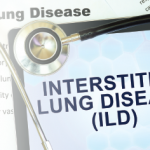
Aquir / shutterstock.com
The U.S. Food & Drug Administration (FDA) approved nintedanib for systemic sclerosis associated interstitial lung disease (SSc-ILD) on Sept. 6 after a randomized, controlled trial (SENSCIS) demonstrated significant benefit against placebo.1 At a cost of $96,000 per year, treatment reduced the adjusted annual rate of change in forced vital capacity (FVC) from –93.3 mL in the placebo group to –52.4 mL in the nintedanib group, or a “relative difference of 44%,” according to a press release from the manufacturer.2 (click here for a study summary.)
Rheumatologists and the media have been understandably enthusiastic about a new therapy for SSc-ILD. However, a closer analysis of the data may temper expectations.
Exaggeration of Effect
For starters, reporting the relative difference in FVC decline exaggerates the treatment effect. At one year, the FVC in both groups worsened. Patients treated with nintedanib declined by 1.4% compared with 2.6% in the placebo group—an absolute difference of only 1.2%. This more closely approximates the patient experience, which almost certainly did not approach a 44% improvement in quality of life. In fact, patients reported no subjective improvement at all. Neither the FACIT-Dyspnea (Functional Assessment of Chronic Illness Therapy—Dyspnea) nor the HAQ-DI (Health Assessment Questionnaire without Disability Index) differed between groups.
This should not be surprising; a 1.2% absolute decline of FVC does not meet any minimal clinically important difference thresholds.3,4 A stringent threshold of >10% was met by 7.0% in the nintedanib group and 8.3% in the placebo group (1.3% absolute difference; number needed to treat [NNT] of 77 patients). The difference for an FVC decline of >5% was larger, with a reduction of 20.6% in the nintedanib group and 28.5% in the placebo group (absolute difference of 7.9%; NNT of 13 patients). Even accepting a low bar for a minimal clinically important difference, 13 patients would need to be treated with nintedanib for one to benefit.
This modest effect shrinks among patients already receiving mycophenolate mofetil (MMF), the standard of care for SSc-ILD, which was taken by only half of the patients in this trial. Among these patients, the benefit of nintedanib fell from 41 mL less FVC decline per year to 26 mL less FVC decline per year. This was not a statistically significant difference. Similarly, nintedanib did not confer a significant benefit among patients with limited systemic sclerosis, who made up 48% of the population studied. Had this trial been performed on patients receiving background MMF or with limited systemic sclerosis, it may not have shown significant benefit or been approved by the FDA.
Side Effects
Most importantly, nintedanib is not a benign therapy. Treatment caused increased rates of diarrhea (75.7% vs. 31.6% placebo, number needed to harm [NNH] 2), vomiting (24.7% vs. 10.4% placebo, NNH 7) and weight loss (11.8% vs. 4.2% placebo, NNH 13). Many patients with systemic sclerosis can ill afford such side effects. In this trial, the rate of events that were “incapacitating or that caused an inability to work or to perform usual activities” was high (18.1% vs. 12.5% placebo, NNH 17.9). In the real world, with less intensive monitoring, it could be even worse.
Even accepting a low bar for a minimal clinically important difference, 13 patients would need to be treated with nintedanib for 1 to benefit.
Target Its Use
Selecting patients for therapy appropriately may mitigate these issues. The modified Rodnan skin score did not differ between groups, and nintedanib should not be offered as a treatment for skin disease. Limiting use to patients with diffuse systemic sclerosis or MMF intolerance may further focus treatment on the population most likely to benefit.
Conversely, nintedanib could be avoided in patients with low body mass index who can least afford weight loss. Such an approach would substantially reduce the eligible pool of patients and has not been studied. Physicians should be aware, though, that not all subgroups experienced a statistically significant or clinically meaningful benefit from therapy.
In summary, the benefit of nintedanib is modest at best. In subgroup analysis, patients receiving the standard of care or with limited systemic sclerosis did not significantly benefit. Quality of life did not improve, either with regard to FACIT-Dyspnea or HAQ-DI. The most likely outcome from therapy for the majority of patients will be adverse events. Strategies to mitigate these risks may help, but they remain untested.
Patients with systemic sclerosis ILD need new options, but rheumatologists should be cautious in offering them nintedanib.
 Michael Putman, MD (@EBRheum), is a clinical instructor of medicine at Northwestern University and a member of the Fellows-in-Training Subcommittee. He is pursuing large vessel vasculitis research on a T32 training grant.
Michael Putman, MD (@EBRheum), is a clinical instructor of medicine at Northwestern University and a member of the Fellows-in-Training Subcommittee. He is pursuing large vessel vasculitis research on a T32 training grant.
References
- Distler O, Highland KB, Gahlemann M, et al. Nintedanib for systemic sclerosis-associated interstitial lung disease. N Engl J Med. 2019 Jun 27;380(26):2518–2528.
- Phase III study showed nintedanib slows the loss of pulmonary function in people living with systemic sclerosis associated ILD (press release). Boehringer Ingelheim.
- Wells AU. Forced vital capacity as a primary end point in idiopathic pulmonary fibrosis treatment trials: Making a silk purse from a sow’s ear. Thorax. 2013 Apr;68(4):309–310.
- Kafaja S, Clements PJ, Wilhalme H, et al. Reliability and minimal clinically important differences of forced vital capacity. Results from the Scleroderma Lung Studies (SLS-I and SLS-II). Am J Respir Crit Care Med. 2018 Mar 1;197(5):644–652.
Note: This article is the opinion of the author and does not necessarily represent the views of the ACR or The Rheumatologist.

